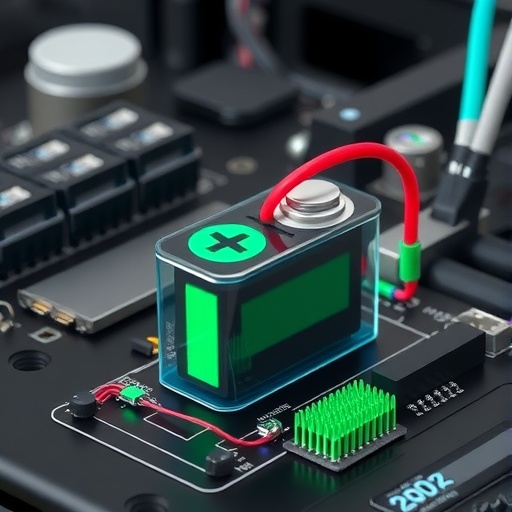In a significant stride toward enhancing the performance and longevity of power batteries, researchers Xu, Ma, and Zhang have introduced a groundbreaking hybrid neural network model that merges Nonlinear Autoregressive Exogenous (NARX) and Bidirectional Long Short-Term Memory (BiLSTM) architectures. This innovative approach targets the estimation of State of Health (SOH) and Remaining Useful Life (RUL) for batteries, offering a more reliable method of forecasting their performance in real-world applications. As electric vehicles and renewable energy storage systems continue to proliferate, the insights provided by this research could be pivotal in optimizing battery management systems.
The development of this hybrid neural network stems from the growing need for reliable predictive maintenance strategies in battery technology. The SOH and RUL are critical parameters that indicate a battery’s operational capability and how much longer it can be expected to function effectively. Traditionally, estimating these parameters has relied on conventional statistical methods, which often fall short in the face of complex, non-linear behaviors exhibited by modern batteries under various operating conditions.
Utilizing the NARX architecture allows the model to capture the time-dependent features of the battery’s performance data effectively. NARX networks are adept at making predictions based on past values of both the output variable and input exogenous variables. This characteristic is vital for battery systems that exhibit a high degree of temporal variation in performance, particularly under varying charge and discharge cycles. The integration of exogenous variables—such as temperature, voltage, and current—provides a more comprehensive view of the influencing factors affecting battery performance.
On the other hand, the BiLSTM component of the model incorporates a bidirectional approach to processing sequential data. In a typical LSTM network, information is processed in one direction—either forward or backward through time. However, in a BiLSTM, data is analyzed in both directions, allowing the model to gain insights from the future context of the data as well as the past. This dual analysis contributes to a more nuanced understanding of battery behavior, ultimately leading to more accurate SOH and RUL estimations.
The combination of NARX and BiLSTM architectures culminates in a robust framework capable of learning from historical battery performance data while incorporating real-time contextual factors. This sophistication in design addresses the limitations faced by simpler models, enhancing the prediction accuracy significantly. In numerous experiments, the hybrid model demonstrated superior performance compared to traditional methods, validating its effectiveness and reliability in real-world scenarios.
Moreover, this research underscores the importance of machine learning in progressive battery management systems. As stakeholders in electric mobility and renewable energy solutions strive for increased efficiency, integrating advanced analytical tools into battery management represents a paradigm shift. The potential for predictive maintenance minimizes operational risks, extends battery lifespan, and maximizes the overall efficiency of energy deployment systems.
As this study unfolds in the academic community, it opens the door for future research avenues. There is immense potential to further refine these models, perhaps through the incorporation of additional neural network strategies or novel machine learning techniques. Enhancements could include incorporating more granular data, exploring different network architectures, or implementing ensemble learning strategies to amalgamate various predictive models for better results.
The hybrid model’s implications stretch beyond just the realm of power batteries. By demonstrating the efficacy of combining different neural network architectures, this research can inspire further innovations in other sectors reliant on predictive maintenance, such as aerospace engineering, manufacturing processes, and even health monitoring systems. These domains could similarly benefit from the ability to forecast system performance based on intricate historical data combined with real-time variables.
Industry adoption of this kind of advanced predictive modeling can influence battery design and manufacturing processes. With insights derived from accurate SOH and RUL estimations, manufacturers can adjust their production methods, choose materials more judiciously, and innovate designs that enhance the sustainability and performance of their products. Furthermore, this research could help shape regulatory standards around battery usage and recycling, supporting broader environmental objectives.
As the world increasingly shifts towards sustainable energy solutions, understanding and managing battery health becomes paramount. The implications of this research reach far into the future of energy technologies, potentially reshaping how we interact with power storage systems. The findings articulate a clear vision for where the future of battery technology is headed—toward smarter, more adaptive, and ultimately more efficient systems that can respond to their environmental needs dynamically.
In summary, Xu, Ma, and Zhang’s pioneering hybrid neural network model marks a transformative step in battery technology, establishing a novel framework that combines predictive capabilities with an understanding of complex variables influencing battery performance. The research not only advances the scientific community’s understanding of battery dynamics but also provides an essential tool for industries that rely heavily on these power sources. As we look to the future, such innovations will undoubtedly play a crucial role in the transition to a more sustainable, energy-efficient world.
Subject of Research: Estimation of State of Health (SOH) and Remaining Useful Life (RUL) of power batteries using hybrid neural network models.
Article Title: A hybrid neural network based on the NARX-BiLSTM for SOH and RUL estimation of power battery.
Article References:
Xu, J., Ma, J., Zhang, K. et al. A hybrid neural network based on the NARX-BiLSTM for SOH and RUL estimation of power battery. Ionics (2025). https://doi.org/10.1007/s11581-025-06727-x
Image Credits: AI Generated
DOI: https://doi.org/10.1007/s11581-025-06727-x
Keywords: hybrid neural network, NARX, BiLSTM, State of Health, Remaining Useful Life, power battery, predictive maintenance, machine learning, energy efficiency, battery management systems.
Tags: Advanced battery technology solutionsBattery health estimationBidirectional Long Short-Term Memory BiLSTMelectric vehicle battery managementHybrid neural network modelNon-linear behavior in batteriesNonlinear Autoregressive Exogenous NARXPredictive maintenance strategiesRemaining Useful Life RUL forecastingRenewable energy storage optimizationstate of health (SoH) predictionTime-dependent performance data analysis





